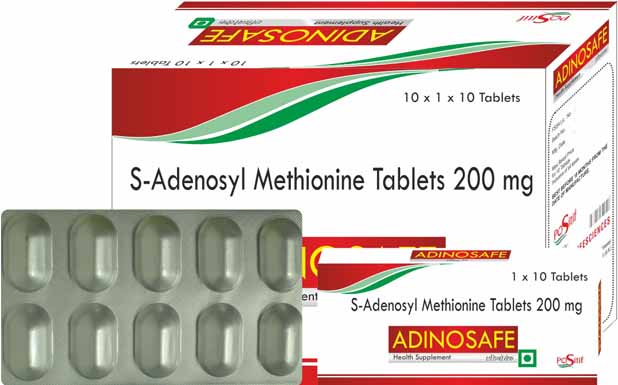S-Adenosylmethionine (SAMe) is a naturally-occurring compound found in almost every tissue and fluid in the body. It is involved in many important processes. SAMe plays a role in the immune system, maintains cell membranes, and helps produce and break down brain chemicals, such as serotonin, melatonin, and dopamine. It is made from adenosine triphosphate (ATP) and methionine by methionine adenosyltransferase.
Disclaimer:The data uploaded is made from content already available on internet.The company holds no right of it and is not responsible for any wrong information.
People take supplements to make sure they get enough essential nutrients and to maintain or improve their health.
Functions of S-Adenosyl-L-Methionine:
SAMe is essential for three key metabolic pathways:
● Transmethylation
● Transsulfuration
● Polyamine synthesis
In Transmethylation reactions, SAMe donates a methyl group to a wide variety of substrates including DNA, proteins, neurotransmitters and phospholipids.
In Transsulfuration reactions, SAMe is converted to cysteine; precursor of glutathione, major cellular antioxidant. SAMe also stimulate synthesis of the proteoglycans used for cartilage regeneration.
In Polyamine Synthesis/Aminopropylation, SAMe is involved in synthesis of the polyamines spermidine and spermine through the aminopropylation pathway. Spermidine and spermine have anti-inflammatory and analgesic effects. Polyamines are involved in regulation of cell growth.
Indication
● An effective aid in reducing the symptoms of depression, liver problems and in treating osteoarthritis.
● Supports joint health
● Supports Brain metabolism and mood
● Supports Liver function
Mechanism of action
S-adenosylmethionine is an intermediate metabolite of methionine. Its involvement in methylation assists in cellular growth and repair maintains the phospho-bilipid layer in cell membranes. It also helps in the maintenance of the action of several hormones and neurotransmitters that affect mood. The highest concentration is found in the brain and the liver.
S-Adenosylmethionine is absorbed from the small intestine following oral intake. As absorption is affected by food, it is best to take on an empty stomach. Significant first-pass metabolism in the liver. Approximately 50% of S-Adenosylmethionine (SAMe) is metabolized in the liver. SAMe is metabolized to S-adenosylhomocysteine, which is then metabolized to homocysteine. Homocysteine can either be metabolized to cystathionine and then cysteine or to methionine.
Contraindication
● Renal and hepatic impairment.
● Do not consume alcohol.
● Contraindicated in persons having known hypersensitivity to any ingredient in this product.
Drug Interactions
S-Adenosyl-L-Methionine can interact with the following drugs:
● Dextromethorphan
● Medications for depression (Antidepressant drugs)
● Tramadol
Side Effects
● Digestive problems, such as nausea, diarrhea or constipation
● Mild insomnia
● Dizziness
● Irritability
● Anxiety
● Sweating
Special Precaution (For Pregnancy and Breast – Feeding mothers)
Not recommended
Storage
Store in a cool, dry & dark place. Protected from light.
